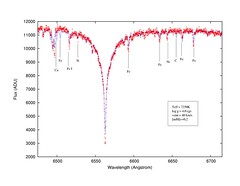 dDor/dSct hybrid spectra.
dDor/dSct hybrid spectra.
Originally uploaded by Astro Guy.Been awhile since I blogged last, been quite busy and haven't had much to say. I did manage to submit a paper on the discovery of a hybrid gamma Doradus/ delta Scuti pulsator. I've talked about this really cool star in the past. I was very interested to get a spectra of the star and get some basic stellar parameters. From a literature search I could only find a sketchy effective temperature of 6500K which was too cool to be placed properely in the observed instability strips.
I contacted DAO and a week later I received the spectra above. The spectra has a resolution of about 20000 centred on H alpha (the big absorption feature in the middle). Even at this medium resolution one can see the rotational broadening of the lines. It's about 35 km/s, well about the instrumental broadening of about 18 km/s. So it's got a significant rotation (this is important!)
Next I computed a grid of Atlas 9 model spectra (Kurucz models) to get an estimate of the effective temperature and surface gravity. The strength of H alpha points to an effective temperature of 7250K and log g = 3.7 cgs. This is much better as it moves this star into the observed delta Scuti and gamma Doradus instability strips. The star is also a bit evolved off the ZAMS. ZAMS stars have log g=4.3.
The next finding was to check the abundance patterns. I've labeled some of the strong elemental lines such as iron. In general the iron lines are observed to be a bit stronger than compared to a solar abundance. The Ca line is also very weak which is an indicator of an Am star. The physical process at play here is diffusion. Some elements are good light absorbers and get pushed to the surface of the star, others are pulled down by gravity. Only elements at the surface of the star (in the photosphere) show up in the spectra as stellar material becomes complete ionized towards the center of the star.
So whats the punchline? Well, the role of diffusion is Am stars is the number or reason for muted pulsations. One needs partial ionization zones to drive the star. Add a bit of rotation and you can counter the effects of diffusion. On top of that there are only 4 hybrid pulsators currently known or which 3 are Am stars and the 4th is binary. Think I've found a neat star to study for a while! Can't wait to learn more.

